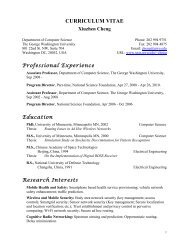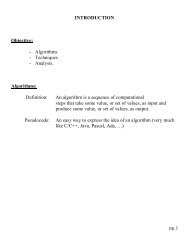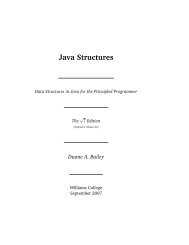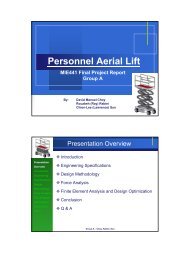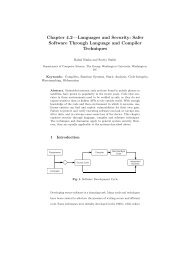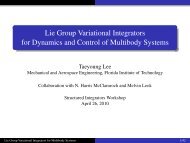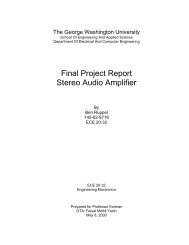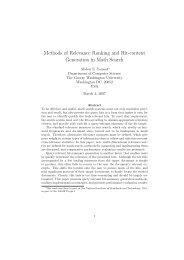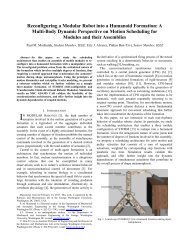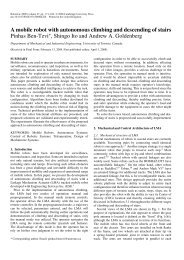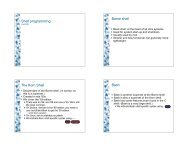Design and Analysis of a Hybrid Mobile Robot Mechanism ... - SEAS
Design and Analysis of a Hybrid Mobile Robot Mechanism ... - SEAS
Design and Analysis of a Hybrid Mobile Robot Mechanism ... - SEAS
You also want an ePaper? Increase the reach of your titles
YUMPU automatically turns print PDFs into web optimized ePapers that Google loves.
Fig. 6<br />
Deployed-link configuration mode <strong>of</strong> the mobile robot<br />
5 Mechanical <strong>Design</strong> Architecture<br />
This section presents one implementation <strong>of</strong> the design concept<br />
as a case study. The presented case aims at describing the design<br />
structure as well as specific design issues <strong>and</strong> design novelties in<br />
detail. The case study provides a design solution selected from a<br />
range <strong>of</strong> alternatives that are described in Secs. 4.1 <strong>and</strong> 4.6. These<br />
solutions, generated from the conceptual function-oriented analysis,<br />
could be readily used in the development <strong>of</strong> various types <strong>and</strong><br />
configurations <strong>of</strong> robots.<br />
Figure 6 shows the complete mechanical design architecture <strong>of</strong><br />
the mobile robot mechanism with all covers removed. It embodies<br />
the conceptual design architecture described in Sec. 4.1, <strong>and</strong><br />
includes the following design specifications <strong>and</strong> requirements: i<br />
design <strong>and</strong> package the manipulator arm <strong>and</strong> the mobile platform<br />
as one entity rather than two separate mechanisms; ii integrate<br />
the manipulator arm into the platform such that to eliminate its<br />
exposure to the surroundings; iii nest all robot links <strong>and</strong> the<br />
end-effector into each other to allow complete symmetry <strong>of</strong> the<br />
platform’s geometry; iv provide the ability to deploy/stow the<br />
manipulator arm from either side <strong>of</strong> the platform; v integrate<br />
passive wheels into the robot joints in order to support the robot<br />
links when used for locomotion/traction; vi integrate each link<br />
with a revolute joint <strong>and</strong> to be able to provide continuous 360 deg<br />
rotation; vii attach rounded <strong>and</strong> pliable covers to the sides <strong>of</strong> the<br />
platform to prevent immobilization as well as to absorb some <strong>of</strong><br />
the energy resulting from falling or flipping over <strong>of</strong> the robot; <strong>and</strong><br />
viii embed interchangeable track tension <strong>and</strong> suspension mechanism<br />
in the mobile robot base links to form the locomotion subsystem<br />
<strong>of</strong> the robot.<br />
The design includes two identical base link tracks left <strong>and</strong><br />
right, Link 2, Link 3, passive wheels, <strong>and</strong> end-effector mechanism<br />
Fig. 6, Detail A. The two base links have identical orientations<br />
<strong>and</strong> they move together. This is achieved by fixing each <strong>of</strong><br />
the base links to the ends <strong>of</strong> one common shaft. The common<br />
shaft is stationary <strong>and</strong> is located in Joint 1, as shown in Figs. 6 <strong>and</strong><br />
8. To support the symmetric nature <strong>of</strong> the design, all links are<br />
integrated into the platform such that they are nested into one<br />
another. Link 2 is connected between the left <strong>and</strong> right base link<br />
tracks via Joint 1 <strong>and</strong> is rotating about the main common shaft.<br />
Passive wheels are inserted between Links 2 <strong>and</strong> 3 <strong>and</strong> connected<br />
via Joint 2 <strong>and</strong> another passive wheel is inserted between Link 3<br />
<strong>and</strong> the end effector via Joint 3. The design also includes a built-in<br />
dual-operation track tension <strong>and</strong> suspension mechanism situated<br />
in each <strong>of</strong> the base link tracks <strong>and</strong> is described in detail in Sec. 5.3<br />
<strong>and</strong> analyzed <strong>and</strong> simulated in Sec. 6.2. This section describes the<br />
platform drive system, arm joint design <strong>and</strong> integration <strong>of</strong> the arm<br />
into the platform, as well as several specifications <strong>of</strong> the robot<br />
based on a computer-aided design CAD detail design assembly<br />
that was used for the manufacturing <strong>of</strong> the prototype.<br />
Along with the challenge <strong>and</strong> effort to realize the concept into a<br />
feasible, simple, <strong>and</strong> robust design, most <strong>of</strong> the components considered<br />
in this design are <strong>of</strong>f the shelf. The assembly views show<br />
the platform/chassis design <strong>and</strong> the different internal driving<br />
mechanisms along with the description <strong>of</strong> the components used<br />
<strong>and</strong> their function. The closed configuration <strong>of</strong> the robot Fig.<br />
7—all links stowed is symmetric in all directions x, y, <strong>and</strong> z. This<br />
design characteristic is extremely important for significantly enhancing<br />
locomotion ability. As shown in Fig. 7, rounded <strong>and</strong> pliable<br />
side covers are attached on the sides <strong>of</strong> the mobile robot to<br />
prevent immobilization when flipover occurs as well as to absorb<br />
some <strong>of</strong> the energy resulting from falling or flipping over events.<br />
Although the design is fully symmetric, for the purpose <strong>of</strong> explanation<br />
only, the location <strong>of</strong> Joint 1 will be taken as the reference<br />
point, <strong>and</strong> it will be called the front <strong>of</strong> the robot.<br />
5.1 Motor Layout <strong>and</strong> Driving <strong>Mechanism</strong>s. The design includes<br />
four motors situated in the base links <strong>and</strong> two more in the<br />
space available in Link 3 for the gripper mechanism. Of the four<br />
motors located in the base links, two are situated at the back <strong>of</strong><br />
each <strong>of</strong> the base links <strong>and</strong> the other two at the front Fig. 8. All<br />
four motors at the base link tracks are identical Brushless DC<br />
Motors BN34-25EU-02, available from Moog Components<br />
Group with a rated power <strong>of</strong> 363 W <strong>and</strong> a continuous stall torque<br />
<strong>of</strong> 0.7 N m. The motor at the back <strong>of</strong> each base link provides<br />
propulsion to the track attached to that specific base link. The<br />
motion from each motor at the back is transmitted through a 1:32<br />
ratio planetary servo gearhead Series E60, available from Textron<br />
Fluid & Power <strong>and</strong> a 1:2 ratio bevel gear in order to transfer the<br />
motion in a 90 deg angle as well as to amplify the torque capacity<br />
required for propelling the pulleys that drive the tracks. Both mo-<br />
Journal <strong>of</strong> Mechanical <strong>Design</strong> JULY 2008, Vol. 130 / 072302-5<br />
Downloaded 13 Jun 2008 to 128.100.48.224. Redistribution subject to ASME license or copyright; see http://www.asme.org/terms/Terms_Use.cfm



